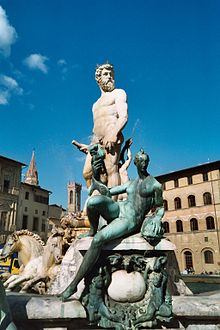Neptune (mythology)

The Roman god Neptune (Latin Neptūnus , Etruscan netun (u) s ) corresponds to the Greek water god Poseidon and was originally believed to be the god of flowing waters, leaping springs or even the weather. From the beginning of the 3rd century BC In BC he was equated with the Greek Poseidon, which also made him the god of the sea . According to mythology, his parents are Saturnus and Ops (or Rhea ) his brothers Pluto and Jupiter , with the latter he also shared control of the upper world. In Roman myth, Neptune was married to Salacia , who corresponds to the Greek Amphitrite . Whether Triton can also be considered his son in Roman mythology is also controversial. It is believed that he had no offspring. His relationship with Jupiter and Pluto is also not proven before the equation with the Greek Poseidon.
In his honor, the Neptunalia were celebrated very early on July 23rd in the Roman Empire . Not much is known about the festival itself, all that is known is that huts were built, but for what purpose is not exactly documented (protection from the sun, stalls, request for rain).
He lived in the depths of the sea with a large retinue of lesser sea deities and was ruler over the sea deities Nereus , Phorkys and Keto, brought forth by Pontus and Gaia . The ancient sources (especially Pliny, Livius and Cassius Dio) pass on at least two places of worship dedicated to him on the Field of Mars in Rome, a temple that dates back to 206 BC. Was consecrated in the area of the Circus Flaminius and the so-called Basilica Neptuni, which was built in 25 BC. By Marcus Agrippa in honor of Augustus, in the immediate vicinity of the Pantheon. He was also worshiped in the provinces and Italian cities outside Rome, especially on rivers, lakes or near the sea.
It remains difficult to differentiate the Greek god Poseidon from the Roman god Neptune, but the two should not be equated.
Attributes
He is usually represented with the trident (Ψ), sea creatures and / or dolphins. With the earthquake-triggering trident, a gift from the Cyclops , he was able to rule the sea, rivers and lakes. The dolphins serve him as messengers. Horses with the shape of fish tails at the back ( hippocamps ) are often added to it .
presentation
Most often, he has a beard and a narrow ribbon is tied in his hair. He is holding his trident in his hand. He often stands on a shell - instead of a cart - pulled by sea horses. Sometimes there are four that can take him in all four directions. Not infrequently he is shown alone, standing in a calm sea, dolphins around him, and looking at a richly laden ship.
Often he puts his foot on a prora . Like the Greek Poseidon, Neptune is often accompanied by Nereids . Like other deities, Neptune was occasionally struck as a motif with his typical attributes on the reverse of Roman coins.
Reception according to antiquity
His statue has been a popular motif on magnificent fountains since the Renaissance.
In the mostly Italian operas of the Baroque period, which deal with mythological themes, the name Neptune - in the Italian form Nettuno - often takes the place of the Greek Poseidon, even if the libretto has a Greek background.
In Telemann's suite Hamburger Ebb 'und Fluth from 1723, the Loure bears the programmatic title “Neptune in love”.
In the visual arts of the baroque era, Neptune embodies water in depictions of the four elements.
In Christian seafaring he comes on board personally at the equator baptism . It is a frequently mentioned topic among sailors - along with the Klabautermann .
In seafaring customs , it is still common today that a glass full of alcoholic drink for Neptune is poured into the sea during a drink .
literature
- Eva Fiesel : netun (u) s . In: Paulys Realencyclopadie der classischen Antiquity Science (RE). Volume XVII, 1, Stuttgart 1936, Col. 142 f.
- Ines Lauffer: Poseidon. In: Maria Moog-Grünewald (Ed.): Mythenrezeption. The ancient mythology in literature, music and art from the beginnings to the present (= Der Neue Pauly . Supplements. Volume 5). Metzler, Stuttgart / Weimar 2008, ISBN 978-3-476-02032-1 , pp. 600-604.
- C. Robert Phillips: Neptunus. In: The New Pauly (DNP). Volume 8, Metzler, Stuttgart 2000, ISBN 3-476-01478-9 , Sp. 841-843.
- Stefan Weinstock: Neptunus. In: Paulys Realencyclopadie der classischen Antiquity Science (RE). Volume XVI, 2, Stuttgart 1935, Sp. 2514-2535.
- Georg Wissowa : Neptunus . In: Wilhelm Heinrich Roscher (Hrsg.): Detailed lexicon of Greek and Roman mythology . Volume 3.1, Leipzig 1902, Sp. 201-207 ( digitized version ).
Web links
- http://imperiumromanum.com/religion/antikereligion/neptunus_01.htm
- Neptune in the Warburg Institute Iconographic Database (approx. 600 photos)
Individual evidence
- ^ Wilhelm Vollmer: Dr. Vollmer's dictionary of the mythology of all peoples . In: reprint . 3. Edition. Hoffmann'sche Verlagbuchhandlung, Stuttgart 1874, p. 347 .
- ^ Benjamin Hederich: Neptunus . In: Thorough Mythological Lexicon. Reprint of the Leipzig, Gleditsch edition, 1770 . Scientific Book Society, Darmstadt 1986, p. 1717 .

